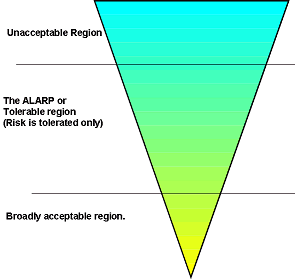What is a safety management system?
How do I implement an effective SMS?
How does BowTie Pro™ Simplify Risk Management?
What is Combined Control Effectiveness?
The As Low As Reasonably Practicable (ALARP) principle forms part of an overall tolerability of risk management described by HSE. This is commonly represented by a triangle.

|
The risk increases from the bottom point of the triangle to the top. The upper limit is regarded as unacceptable whatever the benefits. Any activity or practice falling into this region would normally be ruled out unless action could be taken to reduce the risk into one of the regions lower down the triangle. The bottom of the triangle represents what is known as the broadly acceptable region. Risks falling into this region are regarded as insignificant and adequately controlled. The zone between the unacceptable and broadly acceptable regions (the middle part of the triangle) is known as the tolerable region. Within this region the risks must be controlled to a level that is ALARP. |
The Objective of ALARP
The Objective of ALARP is
How is ALARP demonstrated
The definition above requires that there is a demonstration of cost vs. benefits analysis. BowTie Pro allows controls to be categorised against many measures including cost and benefit
In simple terms this ALARP demonstration should identify both what more could be done (i.e. what additional measures could be put in place) and why these are not necessary . This exercise will:-
Determining that risk has been reduced ALARP
This process can involve varying degrees of rigour which will depend on the nature of the hazard, the extent of the risk and the control measures to be adopted. The more systematic the approach, the more rigorous and more transparent it is to the regulator and other interested parties. However, duty-holders (and the regulator) should not be overburdened if such rigour is not warranted. The greater the initial level of risk under consideration, the greater the degree of rigour HSE requires of the arguments purporting to show that those risks have been reduced ALARP.